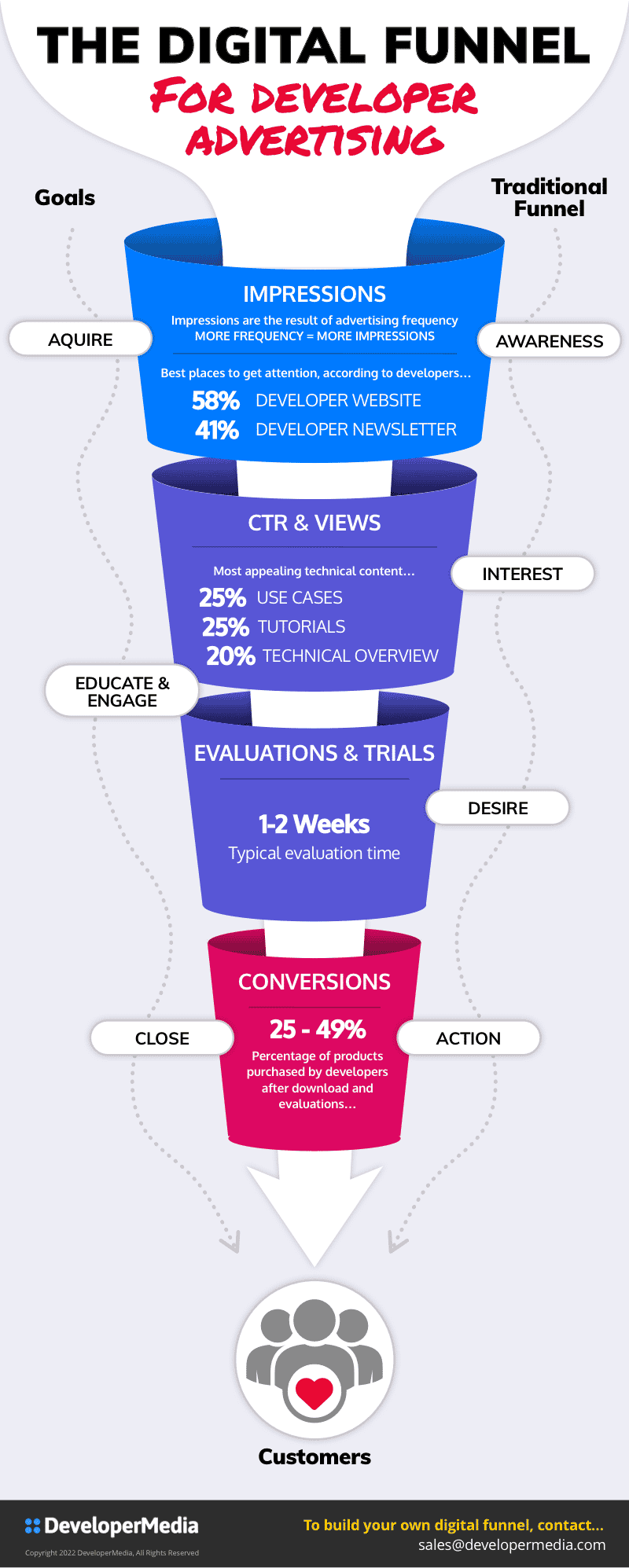Advertising and Search
Advertising and search should be viewed as complementary tactics which can be used to move your target customer from peripheral interest to purchase-ready. Using the Attention – Interest – Desire – Action (AIDA) funnel as a guide, we can see how both fit into the buyer’s journey. The AIDA funnel encapsulates a process; its steps are tunable filters designed to qualify and nurture. By customizing the four filters in the funnel for developers (as we have below), you can achieve your campaign goals and address the needs of your developer audience.
Funnel Vision
The function of advertising is to fill the top of the funnel by attracting attention and building awareness of a need that your brand or product addresses. Once the need surfaces and interest is expressed in the mind of the developer, the search begins.
Developers like alternatives, and they like to know that they are getting the best possible solution to meet their needs. Searching the internet or developer community sites enables developers to uncover alternatives — which can be considered, retained, or discarded — based on supporting content such as use cases, tutorials, videos, or technical content. Search lives in the middle of the funnel, and should be integrated as part of your marketing campaigns.
A Perfect Pairing
Ideally, if developers use search to validate their needs and discover solutions, then their search efforts should lead to the product or brand which created or uncovered the need. So the challenge is to make the journey as frictionless as possible — from first awareness of the need (through advertising) to finding a specific product using advertising and search, all while monitoring the performance of the campaign. Aligning advertising and search reduces friction (imagine coating the walls of the funnel with a ceramic polymer) to speed prospects from awareness to action.
View the funnel as a process, not a series of isolated steps.
Who’s in the Funnel & How to Reach Them
Recent surveys have shown that software tool purchase decisions are not made by a single decision-maker, and they may not necessarily be made by the developer team lead. (Put another way, the purchase approval may be made by the team lead, but with recommendations from front line developers in the trenches, who are ultimately responsible for quality and results.)
A recent post by ContentLab discusses the dynamic found in developer purchase decisions: “Developers aren’t penguins—they aren’t identical. Understanding the developers you are targeting for your product means understanding the prospective users of your product.”
The developer audience is not homogeneous, and different levels of staff will have different goals and various levels of authority forming the Developer Decision-Making Unit, or DDMU. Convincing this audience that your product is the best for their application will require trials, references, endorsements, content, support, and transparency to develop a solid and trusting relationship. You may not need a groundswell of support from the entire team, but their input should be viewed as a part of the purchase decision.
Fallout
When the bottom of the funnel has been reached, you’ll have a group of highly qualified prospects. By the end of the journey, they’ve gone from first impressions to self-education and engagement. They’ve conducted evaluations and trials, and they are ready to convert from a prospect to a customer.
Sales, above all else, is a numbers game. Depending on the desirability and utility of your product, the ratio of impressions to conversions is a function of how well you manage the steps between acquisition and closure (including search). In most cases, you’ll want to keep the top of the funnel filled in order to meet your sales quotas — and this is done through advertising.
Conclusion
You have to fill the funnel to maintain a flow of customers. Advertising, in whatever form it takes, whether newsletters, forums, or sponsorships, fills the funnel. Search is used to qualify and validate decisions, or to seek out new forms of information. A balanced approach using both advertising and search will get you the results you need to reach your developer audience. If you need help crafting an advertising and search strategy, consider working with the experts at DeveloperMedia. They have the experience and expertise to help you optimize your marketing campaign for your developer audience.
References
DeveloperMedia
Home – DeveloperMedia – Reach Millions of Developers
Decision-making Roles
https://developermedia.com/tech-content-strategy-that-addresses-multiple-developer-roles/
AIDA Sales Funnel
https://smaily.com/the-stages-of-a-sales-funnel-and-the-aida-model/
Evans Data Corporation: Developer Marketing Survey 2020
https://evansdata.com/reports/viewRelease.php?reportID=10
ContentLab – Developers as decision-makers




